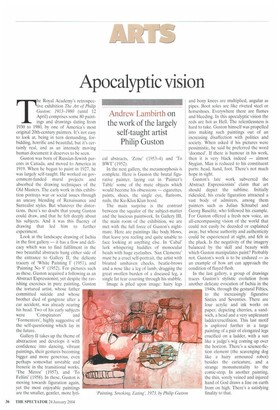Apocalyptic vision
Andrew Lambirth on the work of the largely self-taught artist Philip Guston
The Royal Academy's retrospective exhibition The Art of Philip Guston: 1913-1980 (until 12 April) comprises some 80 paintings and drawings dating from 1930 to 1980, by one of America's most original 20th-century painters. It's not easy to look at, being in turn demanding, forbidding, horrific and beautiful, but it's certainly real, and as an intensely moving human document it deserves to be seen.
Guston was born of Russian-Jewish parents in Canada, and moved to America in 1919. When he began to paint in 1927, he was largely self-taught. He worked on government-funded mural projects and absorbed the drawing techniques of the Old Masters. The early work in this exhibition portrays war or social issues through an uneasy blending of Renaissance and Surrealist styles. But whatever the distortions, there's no doubt that young Guston could draw, and that he felt deeply about his subjects. And it was this fluency of drawing that led him to further experiment.
Look at the landscape drawing of Ischia in the first gallery — it has a flow and delicacy which was to find fulfilment in the two beautiful abstracts hung either side of the entrance to Gallery II, the delicate tracery of 'White Painting I' (1951), and 'Painting No 9' (1952). For pictures such as these, Guston acquired a following as an Abstract Expressionist; yet despite the ravishing exercises in pure painting, Guston the tortured artist, whose father committed suicide and whose brother died of gangrene after a car accident, was already rearing his head. Two of his early subjects were 'Conspirators' and 'Tormentors', highly suggestive of the self-questioning which lay in the future.
Gallery II takes up the theme of abstraction and develops it with confidence into dancing, vibrant paintings, their gestures becoming bigger and more generous, even perhaps somewhat unstable and frenetic in the transitional works, 'The Mirror' (1957), and 'To Fellini' (1958). In these, Guston is moving towards figuration again, yet the most enjoyable paintings are the smaller, gentler, more lyri cal abstracts, 'Zone' (1953-4) and 'To BWT' (1952).
In the next gallery, the metamorphosis is complete. Here is Guston the brutal figurative painter, laying out in 'Painter's Table' some of the mute objects which would become his obsessions — cigarettes, paints, shoes, the single eye, flatirons, nails, the Ku-Klux Klan hood.
The main surprise is the contrast between the squalor of the subject-matter and the luscious paintwork. In Gallery III, the main room of the exhibition, we are met with the full force of Guston's nightmare. Here are paintings like body blows, that leave you reeling and quite unable to face looking at anything else. In 'Cabal' lurk whispering huddles of monocular heads with huge eyelashes. 'San Clemente' must be a cruel self-portrait, the artist with bloated unshaven cheeks, beatle-brows and a nose like a leg of lamb, dragging the great swollen burden of a diseased leg, a single fat tear coursing through his stubble.
Image is piled upon image: hairy legs and bony knees are multiplied, angular as pipes. Boot soles are like riveted steel or horseshoes. Everywhere there are flames and bleeding. In this apocalyptic vision the reds are hot as Hell. The relentlessness is hard to take. Guston himself was propelled into making such paintings out of an increasing disaffection with politics and society. When asked if his pictures were pessimistic, he said he preferred the word 'doomed'. If there is humour in his work, then it is very black indeed — almost Stygian. Man is reduced to his constituent parts: head, hand, foot. There's not much hope in sight.
Guston's late work subverted the Abstract Expressionists' claim that art should depict the sublime. Initially ridiculed, his crude figuration attracted a vast body of admirers, among them painters such as Julian Schnabel and Georg Baselitz, who followed his example. For Guston offered a fresh new voice, an all-encompassing vision of the world that could not easily be decoded or explained away, but whose authority and authenticity could be experienced at sight, and felt in the pluck. Is the negativity of the imagery balanced by the skill and beauty with which Guston manipulates paint? Probably not. Guston's work is to be endured — as an example of how art can approach the condition of flayed flesh.
In the last gallery, a group of drawings traces Guston's stylistic evolution from another delicate evocation of Ischia in the 1940s, through the gestural Fifties, to the increasingly figurative Sixties and Seventies. There are four acrylic and ink works on paper, depicting cherries, a sandwich, a head and a very unpleasant ladder/crucifixion. This last motif is explored further in a large :)ainting of a pair of elongated legs crucified on a ladder, with a sun like a judge's wig coming up over the horizon. There's a science-fiction element (the scavenging dog like a hairy armoured robot) besides the caricature, and a strange monumentality to the comic-strip. In another painting, the thin, sorely veined and injured hand of God draws a line on earth from on high. There's a satisfying finality to that.


























































 Previous page
Previous page